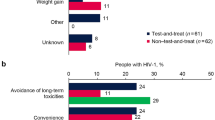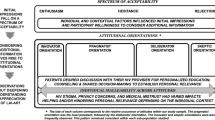Abstract
The study, carriedoutintheFrench MANIF2000 cohortofHIVpositive patients contaminated through injecting drug use, assessed the impact of patients’ sociodemographic and psychological characteristics, behaviors toward drug abuse, and antiretroviral treatment characteristics on the maintenance of adherence to HAART (highly active antiretroviral therapies). A total of 96 patients (30 men and 66 women), who were initially adherent at their first visit after HAART prescription, were considered for analysis. Among these 96 patients, 22 (22.9%) experienced adherence failure defined as a self-reported, non-adherence behavior at any visit before the 18th month of treatment. Logistic regression showed that lack of a stable relationship, active drug injection, and depression were independently associated with adherence failure. Patients’ counseling for facilitating maintenance of adherence to HAART over time should focusonpreventionofdrug use, provisionofsocial support and consider the potential impact of difficulties with treatment on psychological well-being.
Similar content being viewed by others
References
Altice, F., & Friedland,J. (1998). The eraofadherenceto antiretroviral therapy.Annals of Internal Medicine, 129, 503–505.
Avants, S. K., Margolin, A., Warburton, L. A., Hawkins, K. A., & Shi, J. (2001). Predictors of nonadherenceto HIV-related medication regimens during methadone stabilization.American Journal of Addiction, 10, 69–78.
Bangsberg, D. R., Hecht, F. M., Charlebois, E. D.,Zolopa, A. R., Holodniy, M., Sheiner, L., et al. (2000). Adherence to protease inhibitors, HIV-1 viral load, and development of drug resistance in an indigent population.AIDS, 14, 357–366.
Bangsberg, D. R., Perry, S., Charlebois, E. D., Clark, R. A., Roberston, M., Zolopa, A. R., et al. (2001). Non-adherence to highly active antiretroviral therapy predicts progression to AIDS.AIDS, 15, 1181–1183.
Bassetti, S., Battegay, M., Furrer, H., Rickenbach, M., Flepp, M., Kaiser, L., et al. (1999). Why ishighly active antiretroviral therapy (HAART) not prescribed or discontinued? Swiss HIV Cohort Study.Journal of Acquired Immune Deficiency Syndromes, 21, 114–119.
Calabrese, L. H. (2001). Changing patterns of morbidity and mortality in HIV disease.Cleveland Clinical Journal of Medicine, 68, 105, 9–10, 12.
Carr, A., Samaras, K., Burton, S., Law, M., Freund, J., Chisholm, D. J., et al. (1998). A syndrome of peripheral lipodystrophy, hyperlipidaemia, and insulin resistance in patients receiving HIV protease inhibitors.AIDS, 12, F51-F58.
Carrieri, M., Cailleton, V., Le Moing, V., Spire, B., Dellamonica, P., Bouvet, E., et al. (2001). The dynamic of adherence to highly active antiretroviral therapy (HAART): Results from the French National APROCO cohort.Journal of Acquired Immune Deficiency Syndrome, 28, 232–239.
Catz, S. L., Kelly, J. A., Bogart, L. M., Benotsch, E. G., & McAuliffe, T. L. (2000). Patterns, correlates, and barriers to medication adherence among persons prescribed new treatments for HIV disease.Health Psychology, 19, 124–133.
Chesney, M. A., Ickovics, J., Hecht, F. M., Sikipa, G.,; & Rabkin, J. (1999). Adherence: A necessity for successful HIV combination therapy.AIDS, 13, S271-S278.
Chesney, M. A., Ickovics, J. R., Chambers, D. B., Gifford, A. L., Neidig, J., Zwicki, B., et al. (2000). Self-reported adherence to antiretroviral medications among participants in HIV clinical trials: The AACTG adherence instruments. Patient Care Committee and Adherence Working Group of the Outcomes Committeeofthe Adult AIDS ClinicalTrials Group (AACTG).AIDS Care, 12, 255–266.
Chesney, M. A., Morin, M., & Sherr, L. (2000). Adherence to HIV combination therapy.Social Science & Medicine, 50, 1599–1605.
Clumeck, N., Goebel, F., Rozenbaum, W., Gerstoft, J., Staszewski, S., Montaner, J., et al. (2001). Simplification with abacavir-based triple nucleoside therapy versus continued protease inhibitor-based highly active antiretroviral therapy in HIV-1-infected patients with undetectable plasma HIV-1 RNA.AIDS, 15, 1517–1526.
Cook, R. L., Sereika, S. M., Hunt, S. C., Woodward, W. C., Erlen, J. A., & Conigliaro, J. (2001). Problem drinking and medication adherence among persons with HIV infection.Journal of General Internal Medicine, 16, 83–88.
Duong, M., Piroth, L., Peytavin, G., Forte, F., Kohli, E., Graypin, M., et al. (2001). Value of patient self-report and plasma human immunodeficiency virus protease inhibitor level as markers of adherence to antiretroviral therapy: relationship to virologic response.Clinical Infectious Diseases, 33, 386–392.
Duran, S., Saves, M., Spire, B., Cailleton, V., Sobel, A., Carrieri, P., et al. (2001). Failure to maintain long-term adherence to highly active antiretroviral therapy: The role of lipodystrophy.AIDS, 15, 2441–2444.
Duran, S., Solas, C., Spire, B., Carrieri, M. P., Fuzibet, J. G., Costagliola, D., et al. (2001). “Do HIV-infected injecting drug users over-report adherence to highly active antiretroviral therapy?” A comparison between patients’ self-reports and serum protease inhibitor concentrations in the French Manif 2000 cohort study.AIDS, 15, 1075–1077.
Duran, S., Spire, B., Raffi, F., Walter, V., Bouhour, D., Taurnot, J., et al. (2001). Self-reported symptoms after initiationof a protease inhibitorin HIV-infected patients and their impact on adherence to HAART.HIV Clinical Trials, 2, 38–45.
Eron, J. J., Yetzer, E. S., Ruane, P. J., Becker, S., Sawyer, G. A., Fisher, R. L., et al. (2000). Efficacy, safety, and adherence with a twice-daily combination lamivudine/zidovudine tablet formulation, plus a protease inhibitor, in HIV infection.AIDS, 14, 671–681.
Fuhrer, R., & Rouillon, F. (1989). Laversion française de ľéchelle CES-D [Description and translation of the autoevaluation scale].Psychiatrie et Psychobiologie, 4, 163–166.
Gifford, A. L., Bormann, J. E., Shively, M. J., Wright, B. C., Richman, D. D., & Bozzette, S. A. (2000). Predictors of self-reported adherence and plasma HIV concentrations in patients on multidrug antiretroviral regimens.Journal of Acquired Immune Deficiency Syndromes, 23, 386–395.
Gordillo, V., del Amo, J., Soriano, V., & Gonzalez-Lahoz, J. (1999). Sociodemographic and psychological variables influencing adherence to antiretroviral therapy.AIDS, 13, 1763–1769.
Graham, N. M. (1998). Studies of antiretroviral therapy in the Multicenter AIDS Cohort Study.Journal of Acquired Immune Deficiency Syndrome &Human Retrovirology, 17, S9-S12.
Haubrich, R. H., Little, S. J., Currier, J. S., Forthal, D. N., Kemper, C. A., Beall, G. N., et al. (1999). The value of patient-reported adherence to antiretroviral therapy in predicting virologic and immunologic response. California Collaborative Treatment Group.AIDS, 13, 1099–107
Hogg, R. S., Heath, K. V., Yip, B., Craib, K. J., O’Shaughnessy, M. V., Schechter, M. T., et al. (1998). Improved survival among HIV-infected individuals following initiation of antiretroviral therapy.The Journal of the American Medical Association, 279, 450–454.
House, J. (1981).Work, stress, and social support. Reading, MA: Addison-Wesley.
Hung, C. C., Chen, M. Y., Hsieh, S. M., Sheng, W. H., & Chang, S. C. (2000). Clinical spectrum, morbidity, and mortality of acquired immunodeficiency syndrome in Taiwan: A 5-year prospective study.Journal of Acquired Immune Deficiency Syndromes, 24, 378–385.
Johnston-Roberts, K., & Mann, T. (2000). Barriers to antiretroviral medication adherence in HIV-infected women.AIDS Care, 12, 377–386.
Kastrissios, H., Suarez, J., Katzenstein, D., Girard, P., Sheiner, L., & Blaschke, T. (1998). Characterizing patterns of drug-taking behavior with a multiple drug regimen in an AIDS clinical trial.AIDS, 12, 2295–2303.
Lerner, B., Gulick, R., & Dubler, N. (1998). Rethinking non-adherence: Historical perspectives on triple-drug therapy for HIV disease.Annals of Internal Medicine, 129, 573–578.
Levy, R. L. (1983). Social support and compliance: A selective review and critique of treatment integrity and outcome measurement.Social Science & Medicine, 17, 1329–1338.
Liang, K.,; & Zeger, S. (1986). Longitudinal data analysis using generalized linear models.Biometrika, 73, 13–22.
Lucas,G. M., Cheever, L.W., Chaisson, R. E., & Moore, R. D. (2001). Detrimental effects of continued illicit drug use on the treatment of HIV-1 infection.Journal of Acquired Immune Deficiency Syndromes, 27, 251–259.
Mannerheimer, S., Friedland, G., Matts, J., Chen, L., Child, C., McArthur, M., et al. (2000).Self-reported antiretroviral adherence correlates with HIV viral load and declines over time. Presented at XIIIth International AIDS conference, Durban, 2-14, July 2000. Abstract TUORB421.
Max, B.,; & Sherer, R. (2000). Management of the adverse effects of antiretroviral therapy and medication adherence.Clinical Infectious Diseases, 30(Suppl 2), S96-S116.
Miller, L. G., & Hays, R. D. (2000). Adherence to combination antiretroviral therapy: Synthesis of the literature and clinical implications.The AIDS Reader, 10, 177–185.
Moatti, J., Spire, B.,; & Duran, S. (2000). A review of socio-behavioural studies on adherence to antiretroviral treatments: Beyond biomedical models?Revue ďEpidemiologie et de Santé Publique, 48, 182–197.
Moatti, J. P., Carrieri, M. P., Spire, B., Gastaut, J. A., Cassuto, J. P., & Moreau, J. (2000). Adherence to HAART in French HIV-infected injecting drug users: The contribution of buprenorphine drug maintenance treatment. The Manif 2000 study group.AIDS, 14, 151–155.
Molina, J. M., Ferchal, F., Rancinan, C., Raffi, F., Rozenbaum, W., Sereni, D., et al. (2000). Once-daily combination therapy with emtricitabine, didanosine, and efavirenz in human immunodeficiency virus-infected patients.Journal of Infectious Diseases, 182, 599–602.
Morse, E., Simon, P., Coburg, M., Hyssop, N., Greenspan, D.,; & Balson, P. (1991). Determinants of subject compliance within an experimental anti-HIV drug protocol.Social Science & Medicine, 32, 1161–1167.
Murri, R., Ammassari, A., Gallicano, K., De Luca, A., Cingolani, A., Jacobson, D., et al. (2000). Patient-reported nonadherence to HAART is related to protease inhibitor levels.Journal of Acquired Immune Deficiency Syndromes, 24, 123–128.
Ostrop, N. J., Hallett, K. A., Gill, M. J. (2000). Long-term patient adherence to antiretroviral therapy.Annals of Pharmacotherapy, 34, 703–709.
Paterson,D. L., Swindells, S., Mohr, J., Brester, M., Vergis, E.N., Squier, C., et al. (2000). Adherence to protease inhibitor therapy and outcomesinpatients with HIV infection.Annals of Internal Medicine, 133, 21–30.
Pierret, J. (2000). Everyday life with AIDS/HIV: Surveysin the social sciences.Social Science & Medicine, 50, 1589–1598.
Pilisuk, M. (1978). Kinship, social networks, social support and health.Social Science & Medicine, 12, 273–280.
Roca, B., Gomez, C. J., & Arnedo, A. (1999). Stavudine, lamivudine and indinavir in drug abusing and non-drug abusing HIV-infected patients: Adherence, side effects and efficacy.Journal of Infection, 39, 141–145.
Schneiderman, N., Antoni, M. H., Saab, P. G., & Ironson, G. (2001). Health psychology: Psychosocial and biobehavioral aspects of chronic disease management.Annual Review of Psychology, 52, 555–580.
Sherer, R. (1998). Adherence and antiretroviral therapyininjection drug users.The Journal of the American Medical Association, 280, 567–568.
Singh, N., Squier, C., Sivek, C., Wagener, M., Nguyen, M.,; & Yu, V. (1996). Determinants of compliance with antiretroviral therapy in patients with human immunodeficiency virus: Prospective assessment with implications for enhancing compliance.AIDS Care, 8, 261–269.
Smith, M., Rapkin, B., Morrison, A.,; & Kammerman, S. (1997). Zidovudine adherence in persons with AIDS: The relationship of patients beliefs about medication to self-termination of therapy.Journal of General Internal Medicine, 12, 216–223.
Spire, B., Duran, S., Souville, M., Leport, C., Raffi, F.,; & Moatti, J. (2002). Adherence to highly active antiretroviral therapy (HAART) inHIV-infected patients: From a predictive toa dynamic approach.Social Science & Medicine, 54, 1481–1496.
Stein, M. D., Rich, J. D., Maksad, J., Chen, M. H., Hu, P., Sobota, M., et al. (2000). Adherence to antiretroviral therapy among HIV-infected methadone patients: effect of ongoing illicit drug use.American Journal of Drug & Alcohol Abuse, 26, 195–205.
Stone,V. E. (2001). Strategies for optimizing adherence tohighly active antiretroviral therapy: Lessons from research and clinical practice.Clinical Infectious Diseases, 33, 865–872.
Swindells, S., Mohr, J., Justis, J.C., Berman, S., Squier, C., Wagener, M. M., etal. (1999). Qualityoflife in patients with human immunodeficiency virus infection: Impactofsocial support, coping style and hopelessness.International Journal of STDs & AIDS, 10, 383–391.
Wagner, G., & Rabkin, J. (2000). Measuring medication adherence: Are missed doses reported more accurately than perfect adherence.AIDS Care, 12, 405–408.
Wallston, B., Alagna, S., De Vellis, B., & De Vellis, M. (1983). Social support and physical health.Health Psychology, 2, 367–391.
Wasserman, S.,; & Faust, K. (1994).Social network analysis. Cambridge, UK: Cambridge University Press.
Wendel, C. S., Mohler, M. J., Kroesen, K., Ampel, N. M., Gifford, A. L., & Coons, S. J. (2001). Barriers to use of electronic adherence monitoring in an HIV clinic.Annals of Pharmacotherapy, 35, 1010–1015.
Author information
Authors and Affiliations
Corresponding author
Additional information
Special thanks must be addressed to all nurses who were involved in this work and to all patients living with HIV that took part in this study.
Rights and permissions
About this article
Cite this article
Carrieri, M.P., Chesney, M.A., Spire, B. et al. Failure to maintain adherence to haart in a cohort of French HIV-positive injecting drug users. Int. J. Behav. Med. 10, 1–14 (2003). https://doi.org/10.1207/S15327558IJBM1001_01
Issue Date:
DOI: https://doi.org/10.1207/S15327558IJBM1001_01




